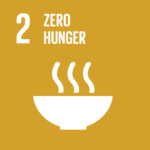The resilient crop, better adapted to climate change: learnings
from Nepal’s farmers experience in reviving ancient grains, foxtail millet.
from Nepal’s farmers experience in reviving ancient grains, foxtail millet.
In the verdant hills of central Nepal’s Lamjung district, a quiet agricultural revolution is taking place. Indigenous Gurung farmers, led primarily by women, are reviving an ancient, climate-resilient crop: foxtail millet. This hardy grain, known locally as bariyo kaguno, is emerging as a beacon of hope amidst the growing challenges of climate change.
RELEVANT SUSTAINABLE GOALS




Smart crops, better adapted to climate change : Foxtail Millet
Foxtail millet, once a staple in Ghanpokhara and other nearby villages, had fallen out of favor in recent decades. However, the rising temperatures, unpredictable monsoons, and increasing droughts — symptomatic of climate change — have led these communities to rediscover its value. This drought-resistant crop, traditionally grown as a famine-resilient grain, offers a vital alternative during the off-seasons for other staples like rice, maize, and wheat.
The revival of foxtail millet in this region has been significantly boosted by the establishment of the Ghanpokhara communal seed bank in 2016. Supported by Local Initiatives for Biodiversity, Research and Development (LI-BIRD) and the Community Seed Bank Association of Nepal (CSBAN), the seed bank plays a pivotal role. It not only provides a reliable market for the farmers but also preserves the genetic diversity of local crop varieties. The bank currently boasts a collection of 63 local rice varieties, including 23 endemic to Ghanpokhara.
Women Leading The Change
Women farmers are at the forefront of this agricultural revival. Out of the 51 farmers currently involved in foxtail millet cultivation in Ghanpokhara, the majority are women. They are not only preserving traditional farming practices but also adapting them to modern needs. For instance, the community has renovated an ancient communal dhiki, a traditional wooden beater, for threshing the millet, blending tradition with current demands.
This resurgence has both economic and environmental benefits. The seed bank ensures a fair and guaranteed price for the farmers, encouraging them to continue cultivating this underutilized crop. The increase in foxtail millet cultivation — from a mere 0.15 hectares to 5 hectares since the seed bank’s inception — is a testament to its growing viability. The fiscal year 2021/22 saw a remarkable 4% increase in millet production nationally, reaching 339,462 metric tons.
Foxtail millet is not just an environmentally sound choice; it’s also a healthier option. Its lower glycemic index makes it suitable for people with type 2 diabetes, increasing its demand in urban areas like Kathmandu.
Reviving Ancient Grains : A Model For Future
The story of foxtail millet in Ghanpokhara is more than just about a crop; it’s about resilience, adaptation, and the power of community in the face of climate change. As the world grapples with the growing impacts of environmental shifts, the model set by the Gurung farmers of central Nepal offers valuable lessons. By reviving traditional crops that are naturally resilient to climate extremes, communities can not only preserve biodiversity but also bolster their food security and economic resilience.
In an era where sustainability and adaptation are key, the revival of foxtail millet in Nepal stands as a shining example of how traditional knowledge, when supported by community-driven initiatives, can offer tangible solutions to global challenges. The Gurung farmers of Lamjung, with their dedication to this ancient grain, are showing the world that sometimes, looking back is the best way to move forward.
Lead image courtesy of LeeJianbing from Getty Images
You may also be interested in :
The Best Forest Managers And Conservation Champions ? Indigenous Peoples, Study Shows


